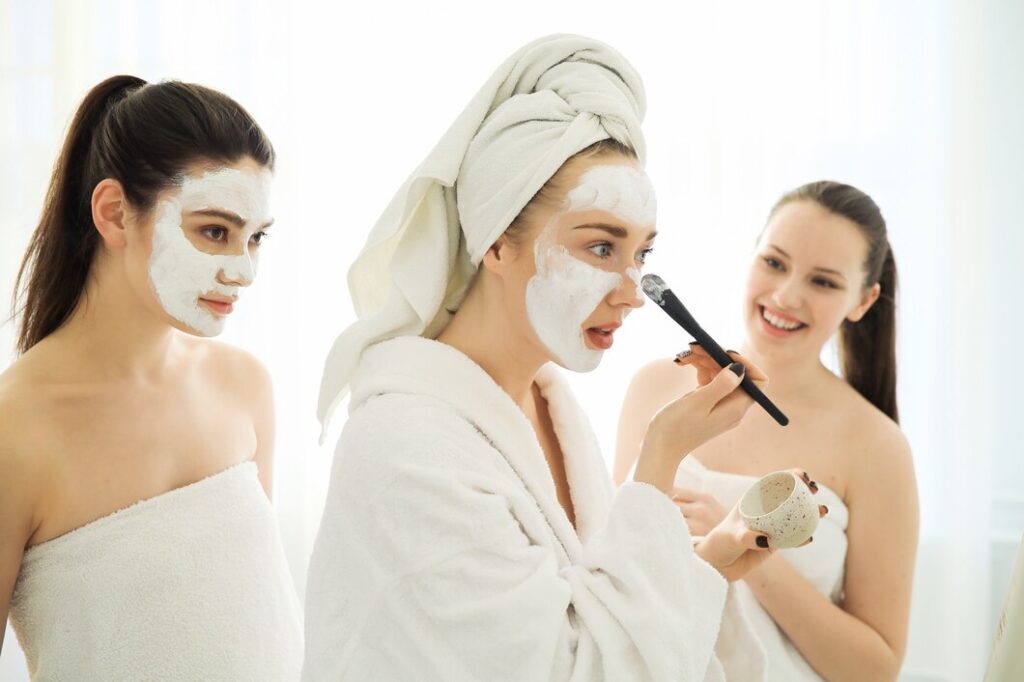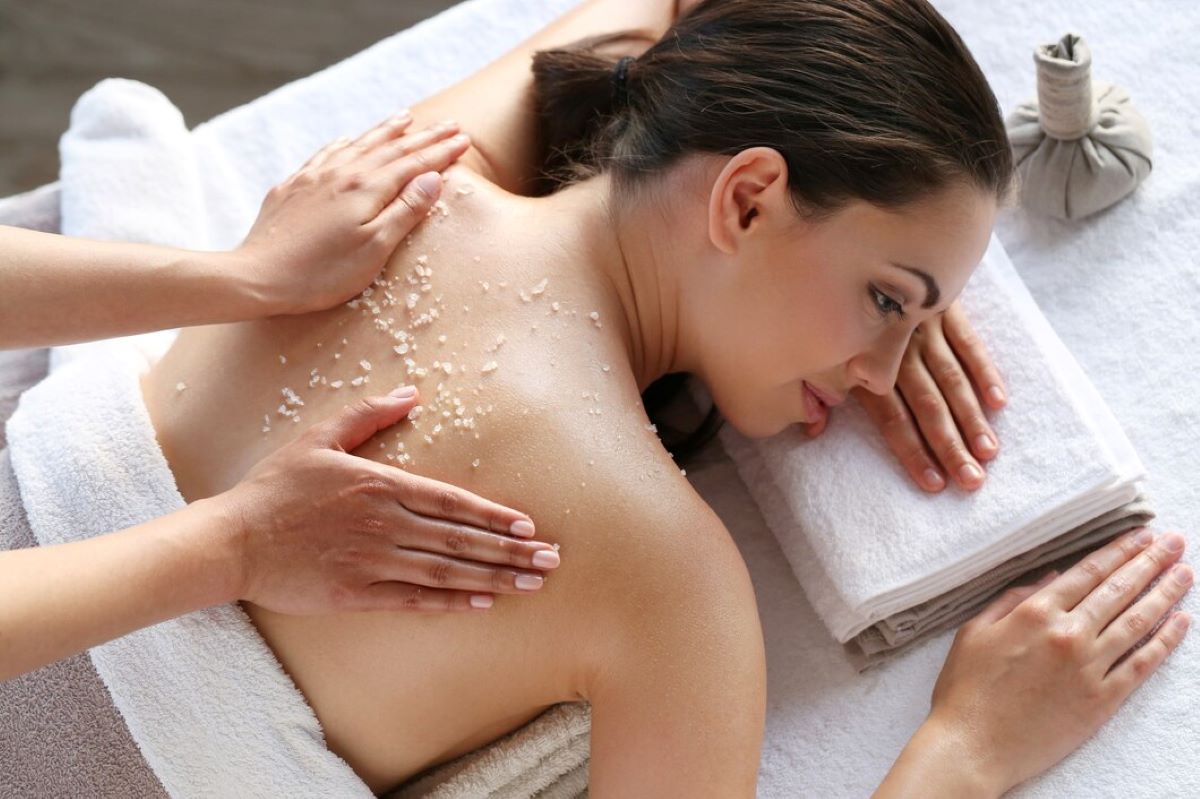There is an article on how to exfoliate your body for soft skin involves covering various aspects, including the benefits, types of exfoliations, methods, products, and precautions.
Table of Contents
1. Understanding Body Exfoliation

What is Exfoliation?
Exfoliation is the process of removing dead skin cells from the surface of the skin. This process helps to reveal newer, fresher skin underneath, promoting a smoother and more radiant appearance. While our skin naturally sheds dead cells, this process can slow down due to factors like aging, environmental damage, and lifestyle choices. Exfoliation aids in maintaining a healthy skin renewal cycle.
Why is Body Exfoliation Important?
Body exfoliation offers several benefits beyond just soft skin. It can help improve circulation, unclog pores, and prevent ingrown hairs. Additionally, it enhances the effectiveness of other skincare products by allowing them to penetrate more deeply. Regular exfoliation can also even out skin tone and reduce the appearance of blemishes and rough patches.
Benefits of Exfoliating Your Body
- Smooth Skin Texture: Exfoliation helps in removing rough and flaky skin, leaving your body smooth and soft.
- Improved Circulation: Physical exfoliation techniques like dry brushing can stimulate blood flow, promoting a healthy glow.
- Better Absorption of Skincare Products: By removing dead skin cells, exfoliation ensures that moisturizers and serums penetrate the skin more effectively.
- Prevention of Ingrown Hairs: Exfoliation helps in keeping hair follicles clear, reducing the likelihood of ingrown hairs.
- Brighter Skin Tone: Regular exfoliation can help to diminish the appearance of dark spots and hyperpigmentation, resulting in a more even skin tone.
2. Types of Body Exfoliation
Physical Exfoliation
Physical exfoliation involves using abrasive substances or tools to manually remove dead skin cells. This method is popular for its immediate results and is suitable for most skin types, with the right products and techniques.
- Scrubs: These are typically made from natural or synthetic particles. Common ingredients include sugar, salt, and coffee grounds. Sugar scrubs are gentle and suitable for sensitive skin, while salt scrubs provide a more intense exfoliation experience. Coffee scrubs, rich in antioxidants, can help to reduce the appearance of cellulite.
- Exfoliating Gloves and Brushes: These tools offer a tactile method of exfoliation. Exfoliating gloves can be used with your favorite body wash or scrub, providing a consistent level of exfoliation. Brushes, particularly dry brushes, are excellent for stimulating circulation and lymphatic drainage.
Chemical Exfoliation
Chemical exfoliation uses acids to dissolve dead skin cells. This method can be particularly beneficial for those with acne-prone or sensitive skin, as it does not involve physical abrasion.
- AHAs (Alpha Hydroxy Acids): AHAs, such as glycolic and lactic acid, are water-soluble and work on the skin’s surface. They are great for improving skin texture and brightness.
- BHAs (Beta Hydroxy Acids): BHAs, like salicylic acid, are oil-soluble and can penetrate deeper into the pores. They are effective for treating acne and blackheads.
Natural Exfoliation
Natural exfoliants use ingredients found in nature, which can be gentle and nourishing for the skin.
- Enzymatic Exfoliants: Derived from fruits like papaya and pineapple, enzymes can break down dead skin cells without causing irritation.
- Herbal and Ayurvedic Methods: These traditional approaches use natural ingredients like chickpea flour, turmeric, and neem, which offer both exfoliation and additional skin benefits.
3. Choosing the Right Exfoliant for Your Skin Type

Different skin types require different exfoliation methods. Choosing the right exfoliant can make a significant difference in achieving soft, healthy skin without causing irritation.
Dry Skin
For dry skin, it’s essential to choose a gentle exfoliant that won’t strip the skin of its natural oils. Enzymatic exfoliants or mild scrubs with moisturizing ingredients like honey or oils are ideal.
Oily Skin
Oily skin can benefit from stronger exfoliants, such as AHAs or BHAs. These ingredients help to unclog pores and control excess oil production.
Sensitive Skin
For sensitive skin, it’s crucial to choose products with soothing ingredients. Avoid harsh scrubs and opt for gentle chemical exfoliants or enzymatic exfoliants.
Combination Skin
Combination skin types can use a mix of exfoliation methods. For example, using a BHA in the T-zone and a gentler exfoliant on drier areas can help balance the skin.
4. Step-by-Step Guide to Exfoliating Your Body
Preparation
Before exfoliating, it’s essential to prepare your skin. This preparation can include a warm shower to open up your pores and soften the skin, making the exfoliation process more effective.
- Pre-Exfoliation Routine: Cleanse your skin to remove any dirt, oil, or makeup. This step ensures that the exfoliants can work directly on the skin surface.
Application Techniques
How you apply your exfoliant matters. Using gentle, circular motions can help prevent skin damage and ensure even coverage.
- How to Apply Scrubs and Other Exfoliants: Use a small amount of product and apply it to wet skin. Massage gently in circular motions, focusing on rough areas like elbows, knees, and heels. Avoid applying too much pressure, as this can irritate the skin.
Post-Exfoliation Care
After exfoliating, it’s crucial to moisturize your skin to lock in hydration and protect the skin barrier.
- Moisturizing and Hydration: Use a rich body lotion or oil to hydrate your skin. Look for ingredients like shea butter, coconut oil, or hyaluronic acid, which are excellent for locking in moisture.
5. Unique and Innovative Exfoliation Techniques

Dry Brushing
Dry brushing is an ancient technique that involves using a dry, natural bristle brush to exfoliate the skin. This method not only removes dead skin cells but also stimulates the lymphatic system, promoting detoxification.
- How to Dry Brush: Start at your feet and brush upwards towards your heart. Use long, sweeping motions and avoid sensitive areas. Dry brushing is best done before showering and should be followed by moisturizing.
Exfoliation with Natural Ingredients
Using natural ingredients can be a gentle and eco-friendly way to exfoliate your body. Here are some DIY recipes:
- Oatmeal and Honey Scrub: Mix ground oatmeal with honey for a soothing and moisturizing scrub. This is perfect for sensitive or irritated skin.
- Sugar and Olive Oil Scrub: Combine sugar with olive oil for a simple yet effective exfoliant. The sugar granules help to remove dead skin cells, while the olive oil nourishes and hydrates the skin.
Hydrotherapy and Exfoliation
Hydrotherapy involves using water to promote wellness and can be combined with exfoliation for a spa-like experience.
- Contrast Showers: Alternating between hot and cold water can stimulate circulation and invigorate the skin. Start with warm water, then switch to cold, and repeat. Afterward, use a gentle exfoliant to remove dead skin cells.
6. Common Mistakes to Avoid
Over-Exfoliation
Exfoliating too often can strip the skin of its natural oils and cause irritation. Most people only need to exfoliate once or twice a week, depending on their skin type.
Ignoring Specific Body Areas
Areas like the back, chest, and feet are often overlooked but can benefit greatly from regular exfoliation. Use a long-handled brush for hard-to-reach areas like your back.
Inadequate Moisturization
Exfoliation can leave your skin more vulnerable to moisture loss. Always follow up with a moisturizer to keep your skin hydrated and protected.
7. Tailoring Your Exfoliation Routine

Seasonal Adjustments
Your skin’s needs can change with the seasons. In winter, opt for gentler exfoliants and richer moisturizers, while in summer, you can use more robust exfoliants to combat oiliness and sweat.
Adjusting for Aging Skin
As skin ages, it becomes thinner and more delicate. Opt for gentler exfoliation methods, such as enzymatic or low-strength chemical exfoliants, and ensure you moisturize thoroughly.
Addressing Specific Skin Concerns
If you have specific skin concerns, such as acne, hyperpigmentation, or keratosis pilaris, you may need to adjust your exfoliation routine. Consult a dermatologist for personalized advice.
8. Exfoliation Myths and Facts
Debunking Common Misconceptions
There are many myths about exfoliation, such as the idea that it can thin the skin or that natural ingredients are always better. We’ll explore these misconceptions and provide evidence-based facts.
Scientific Insights on Exfoliation
Exfoliation has been studied extensively, and scientific research provides insights into its benefits and potential drawbacks. We’ll look at the latest findings and how they can inform your exfoliation routine.
9. Exfoliation and Overall Skin Health

How Exfoliation Affects Skin Renewal
Exfoliation accelerates the natural process of skin renewal, promoting the growth of new, healthy skin cells. This process can help to reduce the appearance of fine lines, wrinkles, and other signs of aging.
The Role of Exfoliation in Preventing Ingrown Hairs
Regular exfoliation can prevent ingrown hairs by keeping hair follicles clear of dead skin cells and other debris. This is especially beneficial for those who shave or wax regularly.
Things You Should Know
Exfoliating your body is a simple yet effective way to achieve soft, smooth, and healthy skin. By understanding the different types of exfoliation, choosing the right products, and avoiding common mistakes, you can create a personalized routine that meets your skin’s unique needs. Remember, the key to successful exfoliation is consistency and care. Embrace the journey and enjoy the benefits of radiant, glowing skin.



I have learn several excellent stuff here. Certainly price bookmarking for revisiting. I surprise how a lot attempt you place to create any such fantastic informative website.